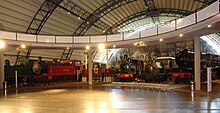Ulster Folk & Transport Museum

Rail Gallery of the Ulster Transport Museum
|
|
| Established | 1967 |
|---|---|
| Location | Cultra, Northern Ireland |
| Coordinates | 54°39′02″N 5°47′55″W / 54.6506°N 5.7986°W |
| Website | www.uftm.org.uk |
The Ulster Folk and Transport Museum is situated in Cultra, Northern Ireland, about 11 kilometres (6.8 mi) east of the city of Belfast. It comprises two separate museums, the Folk Museum and the Transport Museum. The Folk Museum endeavours to illustrate the way of life and traditions of the people in Northern Ireland, past and present, while the Transport Museum explores and exhibits methods of transport by land, sea and air, past and present. The museum ranks among Ireland's foremost visitor attractions and is a former Irish Museum of the Year. It is one of four museums included in National Museums Northern Ireland.
Created by an act of parliament in 1958, the Folk Museum was created to preserve a rural way of life in danger of disappearing forever due to increasing urbanisation and industrialisation in Northern Ireland. The site the museum occupies was formally the Estate of Sir Robert Kennedy, and was acquired in 1961, with the museum opening to the public for the first time three years later in 1964. In 1967, the Folk Museum merged with the Belfast Transport Museum, to form the Ulster Folk and Transport Museum. The museum's Rail and Road Galleries were opened in 1993 and subsequently expanded in 1996. In 1998, the Ulster Folk and Transport Museum merged with the Ulster Museum and the Ulster-American Folk Park [3] to form the National Museums and Galleries of Northern Ireland, now National Museums Northern Ireland.
The Folk Museum houses a variety of old buildings and dwellings which have been collected from various parts of Ireland and rebuilt in the grounds of the museum, brick by brick. 170 acres (0.69 km2) are devoted to illustrating the rural way of life in the early 20th century, and visitors can stroll through a recreation of the period's countryside complete with farms, cottages, crops, livestock, and visit a typical Ulster town of the time called "Ballycultra", featuring shops, churches, and both terraced and larger housing and a Tea room run by Eurest Services, a sub division of the Compass Catering Service. Regular activities include open hearth cooking, printing, needlework, and traditional Irish crafts demonstrations. The allocation of a considerable sum of lottery money has enabled the museum to build a large outhouse in the centre of Ballycultra town. This new structure houses unusual relics from Ulster's past, such as an unusual waffle iron from the mid-19th century, an old 'poteen' distillery from Portmore and the first twin axle bicycle ever seen in Ireland. A little more offbeat is the 'Worlds Largest Sausage', a 17-foot-long (5.2 m) banger, the creation of Newtownards man Seamus McTavish. All these new developments have aided UFTM in developing a new visitor base and have gained the site international recognition.
...
Wikipedia
